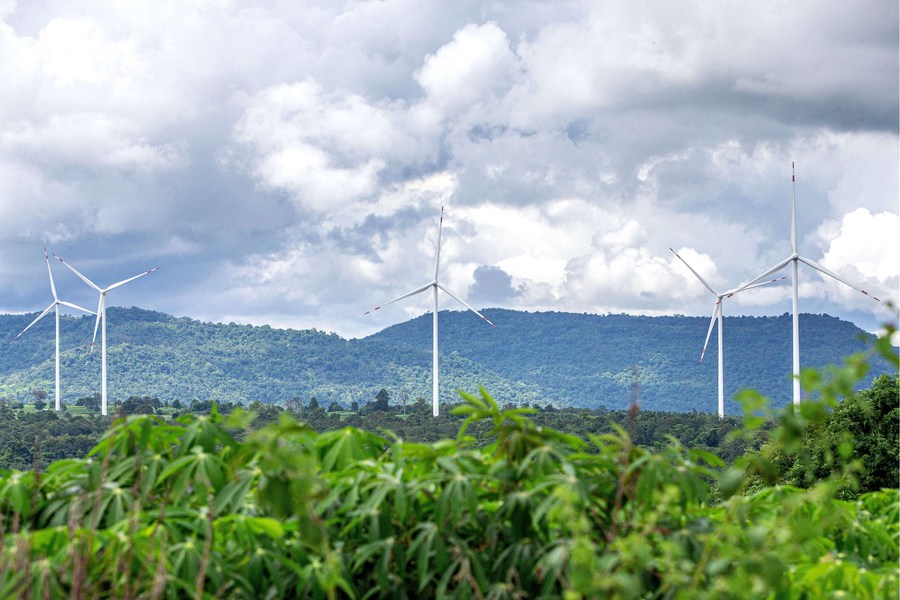Xinhua Commentary: Belt and Road easing poverty, not creating "debt trap"

Children wait to board a train at the Nairobi Station of the Mombasa-Nairobi Railway in Nairobi, Kenya, Oct. 6, 2023. (Xinhua/Wang Guansen)
by Xinhua writers Zheng Bofei, Li Laifang
BEIJING, Oct. 16 (Xinhua) -- As the Belt and Road Initiative (BRI) marks its 10th anniversary, naysayers have pounced on this new chance to impose their old negative theories on this initiative. But their views have no foundation and only mirror issues that are of the West's own making.
The "debt trap" theory is often utilized to smear this milestone project for humanity. However, it is baseless and simply wrong to attribute debt problems of developing countries to the BRI. No participating country has fallen into a debt crisis as a result of BRI cooperation. Rather than creating a "debt trap," the BRI actually helps to alleviate poverty.
Slander and fearmongering by some in the West are consequences of sour grapes they have tasted as a result of the impact of the BRI on their vested economic and geopolitical interests, and their traditional financial dominance in Belt and Road partner countries.
According to World Bank statistics, between 2015 and 2020, commercial and multilateral debts accounted for 42 percent and 35 percent respectively of the new public external debt of low-income and lower middle-income countries. Most of the commercial debts, or 39 percent of the total new debts, are financed by sovereign bonds in the international financial market. A research by Eurodad on 31 key indebted countries found that 95 percent of the countries' sovereign bonds were held by Western financial institutions.
Does the West really care that much about the debt causes of such countries, or is its focus on its own interests? It may be necessary to delve deeper to find real motivations behind the orchestrated "debt trap" smearing campaign aimed at Belt and Road cooperation. What some Western countries are truly concerned about is their own financial interests. They fear the Belt and Road may cut into their pie and reduce business opportunities for their enterprises.
Extensive research conducted by Chinese scholars shows that China's loans for Belt and Road projects have not noticeably aggravated the debt burdens of partner countries, some of which had already accumulated high debt levels before the BRI was proposed in 2013. On the contrary, studies show the BRI has actually helped partner countries reduce their debt by promoting employment, tax revenue, and investment.

This photo taken on Oct. 5, 2023 shows China's Goldwind wind turbines in Chaiyaphum, Thailand. (Xinhua/Wang Teng)
Infrastructure development requires significant investment and takes a long time. That's why some profit-pursuing Western investors are reluctant to commit to such projects. In contrast to those grandiose and unattainable projects proposed by the West for the developing world, China's investments and expertise, preferred by cooperation partners, have delivered realistic and useful projects like railways and ports, which have been the hopes of BRI partner countries for a long time but only made possible by the BRI.
China supports fellow developing countries in their socioeconomic development, conducts investment and financing cooperation with them based on the principle of equality and mutual benefit, and does its best to help them reduce debt burdens. China is not the source of the "debt trap" of developing countries, but a partner to help them get out of the poverty trap.
As a new paradigm of cooperation, the BRI provides a ladder for partner countries to pursue their dreams and modernization. By expanding economic globalization and distributing its benefits fairly, the BRI aims to promote global development that is balanced, coordinated, inclusive and shared by all, and that brings win-win cooperation and common prosperity.
Over the last 10 years, a large number of infrastructure projects under the BRI framework have been built, with significant progress for participating countries in the construction of railways, highways, pipelines, shipping, energy, communications and other basic public service facilities. This has improved locals' living and working conditions and the development environment in BRI partner countries, and boosted their capacity for independent economic development.
As the world's largest platform for international cooperation with more than 150 partner countries, the BRI is bound to deliver more win-win outcomes and help developing countries get out of the poverty trap in the years to come.


